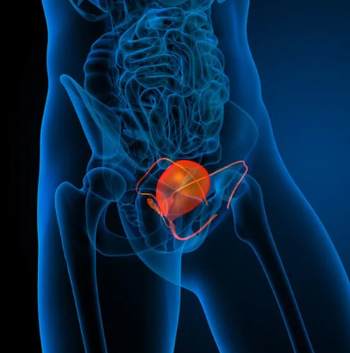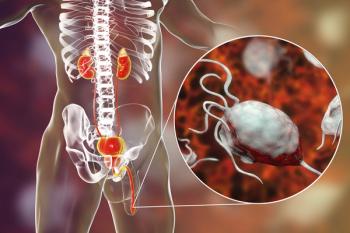
- Oncology Vol 29 No 5
- Volume 29
- Issue 5
Is Radical Prostatectomy Appropriate for Very-High-Risk Prostate Cancer Patients? Yes.
At worst radical prostatectomy is equal to radiation therapy in operable very-high-risk prostate cancer, and there are accumulating data to suggest that a surgery-first approach is better induction for multimodal therapy.
Many have believed that radical prostatectomy (RP) should not be performed if prostate cancer was not likely to be cured. Very-high-risk prostate cancer patients with exam or imaging results concerning for invasion of periprostatic organs, more than four cores of Gleason sum 8–10, or primary Gleason pattern 5 have substantially higher risks for recurrence, progression, and death. The optimal treatment pathway for these patients has not been defined, but they have generally been treated preferentially with external beam radiation therapy (EBRT) plus androgen deprivation therapy (ADT). No useful prospective randomized trials comparing local therapies (RP vs RT) help guide treatment decision making for the very-high-risk prostate cancer patient. However, studies emerging over the last few years suggest that RP is not only appropriate for this population but also may be a more optimal initial treatment, given that many of these patients require multimodal therapy to manage their disease. For the purposes of this article, we are assuming that the prostate is not fixed on examination and is considered operable.
RP has not been shown to be inferior to other treatments with regard to meaningful endpoints such as metastasis or death. The Prostate Cancer Results Study Group examined the prostate-specific antigen (PSA) progression–free survival in high-risk prostate cancer patients and found similar outcomes in those treated with EBRT and RP, with lower PSA progression in those who received combined-modality therapy (brachytherapy + EBRT ± ADT).[1] Unfortunately, PSA progression–free survival is problematic as a comparative endpoint, given that criteria for recurrence differ greatly between RP and RT. Lee et al examined the nomogram-predicted biochemical recurrence (BCR) risks of cohorts treated with RT or RP.[2] Despite similar risks of BCR, the risk of prostate cancer–specific mortality (PCSM) was significantly higher in the EBRT cohort, suggesting that these patients have more advanced disease at the time of recurrence. Increased risk expanded the difference. More specifically, examination of the very-highest-risk men, with progression-free probability of ≤ 25%, revealed that the 10-year PCSM was 21.2% for RP compared with 26.6% for RT. I believe it is safe to assume that more men in the RP cohort received multimodal local therapy (RP plus adjuvant RT). The authors concluded that tools that compare BCR should be used with caution in treatment decision making. Other risk-adjusted comparative studies have not shown a difference in cancer-specific survival between forms of RT and RP in high-risk patients.[3,4]
RP may have superior clinical outcomes compared with RT in very-high-risk prostate cancer patients. Zelefsky et al examined institutional RT and expert surgeon outcomes and balanced the cohorts using pretreatment Kattan nomograms.[5] The RT patients included in this retrospective study were treated with high-dose (81–86 Gy) intensity-modulated radiation therapy with or without short-course ADT. They found that RP patients had a significantly lower risk of metastatic progression (hazard ratio [HR], 0.35) and PCSM (HR, 0.32) than EBRT patients. For very-high-risk patients (assumed 5-year recurrence-free probability of 20%), the 8-year probability of metastasis was ~13% for RP and ~30% for RT. Cooperberg et al also showed improved PCSM for RP compared with RT (HR, 2.21; Kattan nomogram) and primary ADT (HR, 3.22; Kattan nomogram) in patients in the CaPSURE registry.[6] They, too, balanced risk, using pretreatment Kattan nomograms and Cancer of the Prostate Risk Assessment (CAPRA) scores. For very-high-risk patients (assume CAPRA score of 10), the 10-year PCSM was 36% for RP and 47% for RT. Sooriakumaran et al compared risk-adjusted outcomes in almost 35,000 Swedes with prostate cancer treated with RP or RT.[7] They concluded that patients with nonmetastatic disease who underwent RP had better survival than RT-treated patients, and that those with higher-risk cancers who are younger and/or healthier might realize more benefit. In all of the above-mentioned studies, increasing disease risk was associated with greater differences in meaningful outcomes, suggesting that surgery may be the optimal treatment offering for very-high-risk patients. In the Cooperberg and Swedish studies, unmeasured confounders would have to be extremely large and common to overcome the observed differences. Reports showing better results in very-high-risk patients with RT than with RP in regard to meaningful outcomes such as metastatic progression and PCSM do not exist.
There are a few hypotheses as to why RP may be superior to RT in very-high-risk prostate cancer. First, PSA should diminish to very low levels within weeks after surgery. This would allow for earlier detection of recurrent/persistent prostate cancer and the earlier application of salvage therapy in patients who need multimodal treatment. Second, adjuvant or salvage therapies are more uniformly employed after RP, and this use of multimodal therapy may improve outcomes. Zelefsky et al reported a 2% rate of salvage RP after RT, and a 42% rate of salvage RT after RP.[5] The multimodal approach may represent an improved means of cytoreduction or locoregional control for patients with advanced prostate cancer.
It is worth noting that the RT protocols in the cohort reports may differ from contemporary treatment plans that use higher doses of locoregional RT and a longer duration of hormone therapy for high-risk prostate cancer patients. Also, while in most cases RP is straightforward, there are patients who may not be optimal candidates for surgery. Extensive disease invading the bladder neck, pelvic musculature, or ureters may require a more destructive procedure to eliminate the local tumor burden, and in such cases a gentler, RT-based approach seems prudent. Also, none of the above-mentioned studies include adjustment for quality of life, and this deserves careful discussion with the patient. Still, in aggregate, these reports suggest that at worst RP is equal to RT in operable very-high-risk prostate cancer, and there are accumulating data to suggest that a surgery-first approach is better induction for multimodal therapy.
Financial Disclosure:The author has no significant financial interest or other relationship with the manufacturers of any products or providers of any service mentioned in this article.
References:
1. Grimm P, Billiet I, Bostwick D, et al. Comparative analysis of prostate-specific antigen free survival outcomes for patients with low, intermediate, and high risk prostate cancer treatment by radical therapy. Results from the Prostate Cancer Results Study Group. BJU Int. 2012;109(suppl 1):22-9.
2. Lee B, Kibel A, Ciezki J, et al. Are biochemical recurrence outcomes similar after radical prostatectomy and radiation therapy? Analysis of prostate cancer-specific mortality by nomogram-predicted risks of biochemical recurrence. Eur Urol. 2015;67:204-9.
3. Westover K, Chen M-H, Moul J, et al. Radical prostatectomy vs radiation therapy and androgen-suppression therapy in high-risk prostate cancer. BJU Int. 2012;110:1116-21.
4. Kibel A, Ciezki J, Klein E, et al. Survival among men with clinically localized prostate cancer treated with radical prostatectomy or radiation therapy in the prostate specific antigen era. J Urol. 2012;187:1259-65.
5. Zelefsky M, Eastham J, Cronin A, et al. Metastasis after radical prostatectomy or external beam radiotherapy for patients with clinically localized prostate cancer: a comparison of clinical cohorts adjusted for case mix. J Clin Oncol. 2010;28:1508-13.
6. Cooperberg M, Vickers A, Broering J, et al. Comparative risk-adjusted mortality outcomes after primary surgery, radiotherapy, or androgen-deprivation therapy for localized prostate cancer. Cancer. 2010;116:5226-34.
7. Sooriakumaran P, Nyberg T, Akre O, et al. Comparative effectiveness of radical prostatectomy and radiotherapy in prostate cancer: observational study of mortality outcomes. BMJ. 2014;348:1-13.
Articles in this issue
over 10 years ago
Questions We Should Be Asking About Bevacizumab for Cervical Cancerover 10 years ago
Immune Targeting in Breast Cancer: In Whom and With What?over 10 years ago
Anti-Angiogenesis Therapy in Gynecologic Malignanciesover 10 years ago
The Highs and Lows of Targeted Therapiesover 10 years ago
Immune Targeting in Breast CancerNewsletter
Stay up to date on recent advances in the multidisciplinary approach to cancer.


















































































